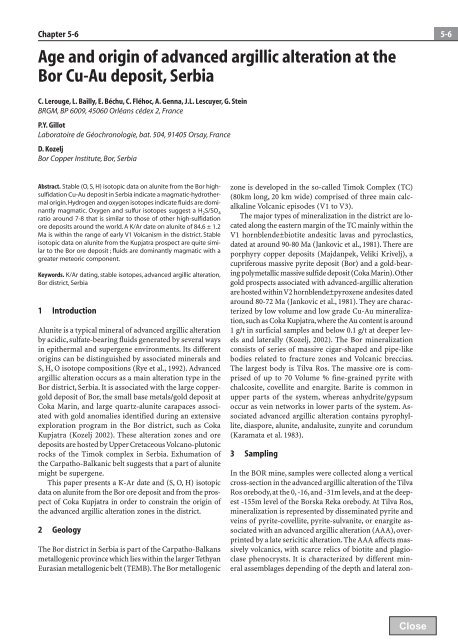Session 5 Epigenetic gold systems - Extra Materials - Springer
Session 5 Epigenetic gold systems - Extra Materials - Springer
Session 5 Epigenetic gold systems - Extra Materials - Springer
Create successful ePaper yourself
Turn your PDF publications into a flip-book with our unique Google optimized e-Paper software.
Chapter 5-6<br />
Age and origin of advanced argillic alteration at the<br />
Bor Cu-Au deposit, Serbia<br />
C. Lerouge, L. Bailly, E. Béchu, C. Fléhoc, A. Genna, J.L. Lescuyer, G. Stein<br />
BRGM, BP 6009, 45060 Orléans cédex 2, France<br />
P.Y. Gillot<br />
Laboratoire de Géochronologie, bat. 504, 91405 Orsay, France<br />
D. Kozelj<br />
Bor Copper Institute, Bor, Serbia<br />
Abstract. Stable (O, S, H) isotopic data on alunite from the Bor highsulfidation<br />
Cu-Au deposit in Serbia indicate a magmatic-hydrothermal<br />
origin. Hydrogen and oxygen isotopes indicate fluids are dominantly<br />
magmatic. Oxygen and sulfur isotopes suggest a H 2 S/SO 4<br />
ratio around 7-8 that is similar to those of other high-sulfidation<br />
ore deposits around the world. A K/Ar date on alunite of 84.6 ± 1.2<br />
Ma is within the range of early V1 Volcanism in the district. Stable<br />
isotopic data on alunite from the Kupjatra prospect are quite similar<br />
to the Bor ore deposit ; fluids are dominantly magmatic with a<br />
greater meteoric component.<br />
Keywords. K/Ar dating, stable isotopes, advanced argillic alteration,<br />
Bor district, Serbia<br />
1 Introduction<br />
Alunite is a typical mineral of advanced argillic alteration<br />
by acidic, sulfate-bearing fluids generated by several ways<br />
in epithermal and supergene environments. Its different<br />
origins can be distinguished by associated minerals and<br />
S, H, O isotope compositions (Rye et al., 1992). Advanced<br />
argillic alteration occurs as a main alteration type in the<br />
Bor district, Serbia. It is associated with the large copper<strong>gold</strong><br />
deposit of Bor, the small base metals/<strong>gold</strong> deposit at<br />
Coka Marin, and large quartz-alunite carapaces associated<br />
with <strong>gold</strong> anomalies identified during an extensive<br />
exploration program in the Bor district, such as Coka<br />
Kupjatra (Kozelj 2002). These alteration zones and ore<br />
deposits are hosted by Upper Cretaceous Volcano-plutonic<br />
rocks of the Timok complex in Serbia. Exhumation of<br />
the Carpatho-Balkanic belt suggests that a part of alunite<br />
might be supergene.<br />
This paper presents a K-Ar date and (S, O, H) isotopic<br />
data on alunite from the Bor ore deposit and from the prospect<br />
of Coka Kupjatra in order to constrain the origin of<br />
the advanced argillic alteration zones in the district.<br />
2 Geology<br />
The Bor district in Serbia is part of the Carpatho-Balkans<br />
metallogenic province which lies within the larger Tethyan<br />
Eurasian metallogenic belt (TEMB). The Bor metallogenic<br />
zone is developed in the so-called Timok Complex (TC)<br />
(80km long, 20 km wide) comprised of three main calcalkaline<br />
Volcanic episodes (V1 to V3).<br />
The major types of mineralization in the district are located<br />
along the eastern margin of the TC mainly within the<br />
V1 hornblende±biotite andesitic lavas and pyroclastics,<br />
dated at around 90-80 Ma (Jankovic et al., 1981). There are<br />
porphyry copper deposits (Majdanpek, Veliki Krivelj), a<br />
cupriferous massive pyrite deposit (Bor) and a <strong>gold</strong>-bearing<br />
polymetallic massive sulfide deposit (Coka Marin). Other<br />
<strong>gold</strong> prospects associated with advanced-argillic alteration<br />
are hosted within V2 hornblende±pyroxene andesites dated<br />
around 80-72 Ma (Jankovic et al., 1981). They are characterized<br />
by low volume and low grade Cu-Au mineralization,<br />
such as Coka Kupjatra, where the Au content is around<br />
1 g/t in surficial samples and below 0.1 g/t at deeper levels<br />
and laterally (Kozelj, 2002). The Bor mineralization<br />
consists of series of massive cigar-shaped and pipe-like<br />
bodies related to fracture zones and Volcanic breccias.<br />
The largest body is Tilva Ros. The massive ore is comprised<br />
of up to 70 Volume % fine-grained pyrite with<br />
chalcosite, covellite and enargite. Barite is common in<br />
upper parts of the system, whereas anhydrite/gypsum<br />
occur as vein networks in lower parts of the system. Associated<br />
advanced argillic alteration contains pyrophyllite,<br />
diaspore, alunite, andalusite, zunyite and corundum<br />
(Karamata et al. 1983).<br />
3 Sampling<br />
In the BOR mine, samples were collected along a vertical<br />
cross-section in the advanced argillic alteration of the Tilva<br />
Ros orebody, at the 0, -16, and -31m levels, and at the deepest<br />
-155m level of the Borska Reka orebody. At Tilva Ros,<br />
mineralization is represented by disseminated pyrite and<br />
veins of pyrite-covellite, pyrite-sulvanite, or enargite associated<br />
with an advanced argillic alteration (AAA), overprinted<br />
by a late sericitic alteration. The AAA affects massively<br />
volcanics, with scarce relics of biotite and plagioclase<br />
phenocrysts. It is characterized by different mineral<br />
assemblages depending of the depth and lateral zon-<br />
5-6

















